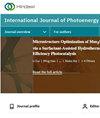Enhancing Photovoltaic Module Fault Diagnosis with Unmanned Aerial Vehicles and Deep Learning-Based Image Analysis
IF 2.1
4区 工程技术
Q3 CHEMISTRY, PHYSICAL
引用次数: 0
Abstract
Artificial intelligence (AI) has evolved into a powerful tool that has wide-spread application in computer vision such as computer-aided inspection, industrial control systems, and navigation of robots. Monitoring the condition of machineries and mechanical components for the presence of faults with the aid of image-based automated analysis is one major application of computer vision. Diagnosing machinery faults from images can be made feasible with the adoption of deep learning and machine learning techniques. The primary objective of this study is to detect malfunctions in photovoltaic (PV) modules by utilizing a combination of deep learning and machine learning methodologies, with the assistance of RGB images captured via unmanned aerial vehicles. Six test conditions of PV modules such as good panel, snail trail, delamination, glass breakage, discoloration, and burn marks were considered in the study. The overall experimentation was carried out in two phases: (i) deep learning phase and (ii) machine learning phase. In the initial deep learning phase, the final fully connected layer of six pretrained networks, namely, DenseNet-201, VGG19, ResNet-50, GoogLeNet, VGG16, and AlexNet, was utilized to extract PVM image features. During the machine learning phase, feature selection from the extracted features was carried out using the J48 decision tree algorithm. Post selection of features, three families of classifiers such as tree, Bayes, and lazy were applied to determine the best feature extractor-classifier pair. The combination of DenseNet-201 features with k-nearest neighbour (IBK) classifier produced the overall classification accuracy of 100.00% among all other pretrained network features and classifiers considered.无人机增强光伏组件故障诊断及深度学习图像分析
人工智能(AI)已经发展成为一种强大的工具,在计算机辅助检测、工业控制系统、机器人导航等计算机视觉领域有着广泛的应用。借助基于图像的自动分析来监测机械和机械部件的故障状态是计算机视觉的一个主要应用。采用深度学习和机器学习技术,从图像中诊断机械故障是可行的。本研究的主要目标是利用深度学习和机器学习方法的结合,在无人机捕获的RGB图像的帮助下,检测光伏(PV)模块的故障。研究中考虑了光伏组件的6个测试条件:面板良好、螺迹、分层、玻璃破碎、变色、烧痕。整个实验分两个阶段进行:(i)深度学习阶段和(ii)机器学习阶段。在初始深度学习阶段,利用DenseNet-201、VGG19、ResNet-50、GoogLeNet、VGG16和AlexNet这6个预训练网络的最终全连接层提取PVM图像特征。在机器学习阶段,使用J48决策树算法从提取的特征中进行特征选择。在特征选择后,应用tree、Bayes和lazy三大类分类器来确定最佳特征提取-分类器对。DenseNet-201特征与k-最近邻(IBK)分类器相结合,在所有其他预训练网络特征和分类器中,总体分类准确率为100.00%。
本文章由计算机程序翻译,如有差异,请以英文原文为准。
求助全文
约1分钟内获得全文
求助全文
来源期刊
CiteScore
6.00
自引率
3.10%
发文量
128
审稿时长
3.6 months
期刊介绍:
International Journal of Photoenergy is a peer-reviewed, open access journal that publishes original research articles as well as review articles in all areas of photoenergy. The journal consolidates research activities in photochemistry and solar energy utilization into a single and unique forum for discussing and sharing knowledge.
The journal covers the following topics and applications:
- Photocatalysis
- Photostability and Toxicity of Drugs and UV-Photoprotection
- Solar Energy
- Artificial Light Harvesting Systems
- Photomedicine
- Photo Nanosystems
- Nano Tools for Solar Energy and Photochemistry
- Solar Chemistry
- Photochromism
- Organic Light-Emitting Diodes
- PV Systems
- Nano Structured Solar Cells

 求助内容:
求助内容: 应助结果提醒方式:
应助结果提醒方式:


